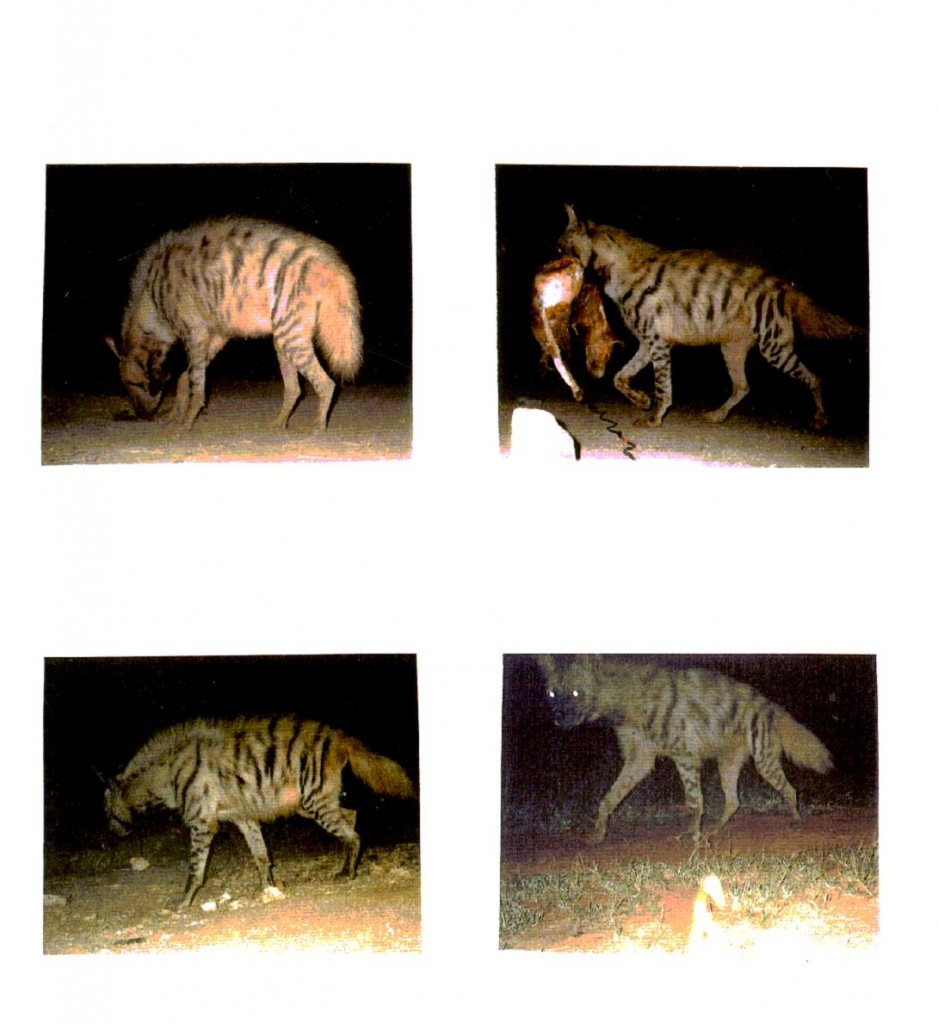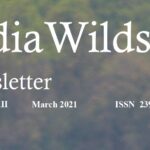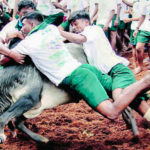Wild India: Ecology of Striped Hyena in Sigur Plateau
Introduction:
My interest to study wildlife started during my school days. I was born in a village that had a wide variety of birds and mammals that are characteristic to the rural ecosystem. I pursued my undergraduate study in zoology and luckily our college had a postgraduate degree in wildlife Biology. So I was lucky enough to complete my postgraduate degree in Wildlife Biology. Just after the completion of my PG degree I got an opportunity to work in the Center for Ecology, Indian Institute of Sciences (IISc) field Research station located in the Mudumalai Wildlife sanctuary (hereafter it will be called as Mudumalai Tiger Reserve). I was given a chance either to work on the elephants or on the carnivores. I opted to study the food habits of elusive carnivores like tiger, leopard and wilddog.
Mudumalai Tiger Reserve has got a variety of habitat that supports very high density of herbivores and that in turn supports several species of carnivores. The researchers in the IISc field research station were given very good cameras like Nikon FM2 SLR film camera and a variety of lenses. I used to go for night photography along a canal that has narrow bridges of approximately 1.5 meter width. These bridges are used by carnivores to cross the canal and the width was not sufficient for large herbivores like elephant or gaur. I used to focus the camera on plants that are approximately 3 to 4 meters away from me when there was sufficient light and I used to wait for animals to come up to the plant and then I used to click the camera. I had a powerful Vivitar external flash attached to my SLR camera. Several nights I use to hear the alarm calls of sambar but I never got a chance to photograph a carnivore. One no moon night while I was waiting on the bridge I heard the laughter sound followed by alarm calls of samber deer, then I could see an animal walking towards the bridge. I waited until that animal came upto the plant, I had focused and once the animal reached near that plant I clicked my camera and the animal got frozen because of the powerful light of the flash. I would have clicked seven eight frames before the animal managed to run back from the direction in which it had come. I then realized that the picture I had taken was that of a striped hyena (Hyena hyena). This incident was elucidated to study the striped hyena in the dry thorn habitat of Mudumalai Tiger Reserve.
The family hyaenidae is represented by four species namely spotted hyena (Crocutta crocutta) brown hyena (Hyena brunnea) striped hyena (Hyena hyaena) and Aardwolf (Protelus cristatus). Their distribution in a variety of habitats in Africa and Asia shows that hyaenids have a wide range of ecological and behavioral adaptation and social organisations (Kruuk, 1972, Mills, 1978). All the four species of hyaenids are found in Africa and striped hyenas distribution extends up to Asia. Striped hyena is found throughout India (Prater, 1948, Krishnan, 1963). Even though a lot of studies are available on the spotted hyenas (Kruuk,1972, Mills,1985, 1990, 1996, Ilenschell et.al.,1990, Frank 2000, Hofer 2000, Korb 2000 and also on the brown hyenas (Mills 1982, 1982a, 1987, Skinner et.al.,1995) practically very little information is available on the striped hyenas with reference to India especially of the Sigur plateau, Nilgiri Biosphere Reserve, Nilgiris, TamilNadu, South India.
Further the environment of the Nilgiri has been subjected to a lot of threats due to developmental activities such as construction of hydroelectric power stations, alteration of natural forests for cultivation of tea, coffee, eucalyptus and wattle plantations. The aforesaid activities have severely affected the larger carnivores such as striped hyenas, leopards (Panthera pardus), dholes (Cuon alpinus); but has not been assessed. The present investigation is an attempt to fill up these lacunae to some extent.
This study was carried out in Sigur plateau (100 sq. km), Nilgiris District, Tamil Nadu, South India. It is located north of The Nilgiri Biosphere Reserve. Champion and Seth (1968) classified the vegetation of this area as open thorn forest. There are eleven villages located within the Sigur plateau. The main occupation of these villagers is cattle grazing and agriculture. As a result of severe cattle grazing pressure the wild ungulates tend to avoid the fringes of forest areas close to the villages resulting in frequent occurrence of killing by larger carnivores. This has lead to human – larger carnivore conflict in these areas. In this context understanding the ecology of hyena is essential for formulating management plans to avert human larger carnivore conflict as well and hence the present study was carried out with the following objectives during 1995 – 2000.
Objectives of study on Striped Hyenas in Sigur Plateau–
- To estimate hyena density in Sigur plateau.
- To assess the habitat use by hyenas in Sigur plateau.
- To study the food habits of hyenas and it’s dietary overlap with dhole and leopards.
- To analyse the micro habitat characteristic features of hyena denning sites
- To assess their natural prey base density in Sigur plateau
- To study the human – larger carnivore conflicts in Sigur plateau and the role of hyenas in the same.
Density and status of hyena was assessed by the camera trap method (Karanth, 1995), direct observations and by indirect signs such as spoors (korb, 2000). Food habit of hyenas was determined by the collection and analysis of scats and by studying the leopard and dhole kills and feeding signs on the animals died of old age and diseases. Hyenas dietary overlap with leopard and dholes was also studied by scats and by observing kills made by leopard and dhole (Johnsingh, 1983). Denning sites of hyenas were located by looking for assemblage of heap of bones and by accumulation of scats along dry nallas in the study area (Kruuk,1972, Mills 1980, Korb 2000). Prey abundance was estimated by the line transect method (Burnham et.al. 1980, Varma et.al.1995). Plant species density and canopy cover in the study area was assessed by quadrat method. Leopard, dhole and hyena – human conflict were studied by direct examination of reported cases of carnivore kills as well as questionnaire surveys.
Preliminary analysis of data showed that there is a high density of hyenas very close to the villages (1/8 Sq. km) and it decreases as one goes away from villages. This showed their high dependence on the cattle of the villages. Camera trap pictures showed that individual hyenas could be distinguished by stripe patterns. Food habit study showed that chital is the main prey base for hyenas, leopards and dholes. The frequency of occurrence of chital remains in hyena, leopard and dhole were 48,85 and79 percent respectively. Cattle prey remains were found in 19 % of hyena scats, 9 % of leopard scats and 4 % of dhole scats and this very clearly showed that leopard plays an important role in human – larger carnivore conflict in this area and hyenas dependence on villages. Preliminary analysis of natural prey base density shows that chital, sambar and black napped hare and the density of cattle using the study area is approximately 50 per Sq. km. Even though cattle density out numbered wild prey species density, the frequency of occurrence of cattle remains in hyena; leopard and dhole scat remains were lesser than that of the wild prey species.
This result clearly showed that larger carnivores are largely depending on the scarcity. Ten hyena dens were located during the study period. Out of these ten dens, eight were located along dry nallas and two were located on a hillock. They were littered with bones and scats and they were located in open areas as well as in dense bushes. This study also showed that leopard and dhole kill cattle in the fringes of forests close to human habitations. This study also revealed that more than 75% of cattle killed by dholes were during dry season and leopard killed cattle almost throughout the year and hyenas scavenged more number of leopard (77%) kills than that of dholes (23%) and this may be due to leopards caching their food for several days whereas dholes usually finish eating their food on the same day in which the kill was made. Poisoning cattle killed by leopard were observed four times and three hyenas died after feeding the poisoned carcasses (one during the study period and two prior). Factors related to such conflicts with humans were discussed. Based on the information gathered management suggestions were also given to mitigate human larger carnivore conflicts in Sigur plateau.
Dead Hyena After Feeding a Poisoned Carcass
Conservation Issues for Hyenas in Nilgiris –
- Development of forest villages is a major threat for wildlife in Nilgiris especially for scavenging animals like hyenas.
- During summer season carnivores like wild dogs (Cuon alpinus), leopards (Panthera pardus) kill cattle due to dispersal of wild ungulates in the forest. Cattle owners in retaliation poison the carcass. Leopards and wild dogs are not known to die due to to poisoning of carcass. Whereas scavenging animals like hyena, crows and vultures eat the poisoned carcass and die.
- Farmers keep country bomb for killing wild boar (Sus scrofa) that come to raid their crop in agriculture field. The smell of fish smeared on the bomb attracts the innocent animal like hyena who are always on the look out for dead animals. They bite the bomb and die due to the resulting bomb explosion.
- Carcases of cattle dying due to old age and disease used to be disposed off in the jungle and were available for hyena to eat. These days cattle owners sell the old animals for beef resulting in less food availability for hyenas.
Key Recommendations for Forest Department to save Hyenas in Wild India –
- The forest department should give compensation for the cattle that get killed by carnivores especially killed by tiger and leopard. This will reduce retaliatory killings of carnivores by the cattle owners.
- Strict vigil should be made by the forest department in the agriculture fileds for country bomb kept for wild pig (Sus scrofa). A heavy penalty should be collected from people who keep country bombs to prevent wild pig (Sus scrofa) coming towards their field.
- A wild animal proof trench should be dug along the boundary to prevent wildlife entering agriculture field. This trench should be managed with help of local people participation.
Please post your views, comments and questions on this article ‘Wild India | Ecology of Striped Hyenas’ in the comments below.
- Wild India | Ecology of Striped Hyena - 14 August,2012
- Road Kills in Chinnar Road and Aliyar - 28 April,2012













Very interesting article . It was news to me that hyenas are found in nilgiris . My three year old has a craze for animals . I am expecting him to end up doing research like u . Too early to predict though . It was good to hear about the courses available related to this .
Thanks for sharing this. Very informative post.
regards,
Anupam
Why can’t hyenas figure out about the poison? Have they no sense of smell? Just curious.
Shovon,
I think Hyenas probably can’t associate the smell of poison with danger. They do have good sense of smell. Tiger’s also get killed by feeding on poisoned carcass. In his famous book “Maneater of Rudraprayag” Jim Corbett had mentioned that he had tried to kill the man-eating leopard of Rudraprayag by using arsenic poison in the kills. However, this man-eating leopard used to carefully choose the areas devoid of poison and leave the rest. A lot of research work needs to go into this area.
Sabyasachi
very informative..loved the read..thanks..
Very informative.
Dear Sir,
Thanks for publishing the results of this pioneering study on one of the least studied carnivores in the country.
Very informative one..really liked reading it. Thanks
You know a lot about wild life-interesting post.
very informative..into the wild….
Thanks a lot for sharing this sir. Realy informative. Do you have books published Or Other Literature for Wildlife enthusiasts to read through ?
Very nice, interesting and informative article.
A very detailed study. Thanks for sharing.
I appreciate your research sir,in Eastern UP and Bihar it is known as Hudaar.In my childhood days many times I heard about child lifting by them.
On last saturday(22/02/2014) evening around 8 PM, i spotted a ‘Spotted Hyena’ in our sugar plantation, in Ugar khurd, Belgaum District of Karnataka. It is bold animal, it did not give damn to flood light used by us. It is big beast.
very great information, I wants to ask one question Sir, stripped hyenas
also have female dominate as in spotted hyenas in Africa..?
Sir it’s really really informative ,I am A.Abinesh and I’m studying MSC zoology (wildlife biology) in Ooty, and im the student of Dr.B.Ramakrishna ur beloved friend,and i am highly interested on working about striped hyaenas from my bsc.ur article is a breakthrough for my further research on hyenas, i really tq for ur informations sir,i hope that I will meet u soon sir ,tq
Indian hyena is a most mysterious animal. I want eager about indian hyena and here is very useful information related hyena thank you sir.
Dear sir,
Thank you so much for your information. i have lots of friends around nilgiris, they used to call one animal as “naai siruthai”. i always wonder what is that animal.. and it made me to search for that mysterious animal. i used to ask them, the looks and behaviour of that animal.. and i finally decided that it should be hyena.. and started surfing about hyenas in nilgiris. i finally got the answer for that “naai siruthai”…!
Hello sir.. just today 3/2/18 i had spotted strip hayenA on mumbai Bangalore highway… i had a clue as it was hit by a car side bumper is it was cricling round..
Do you have an photo Vishal?
Do u know indigenous and common name of striped hyena in different region of india because I need this I..any one help me?
Future of Hayena and wolf in India depend on tolerance of human. Because of habitat overlaping with human there is bound to be clash of interest.